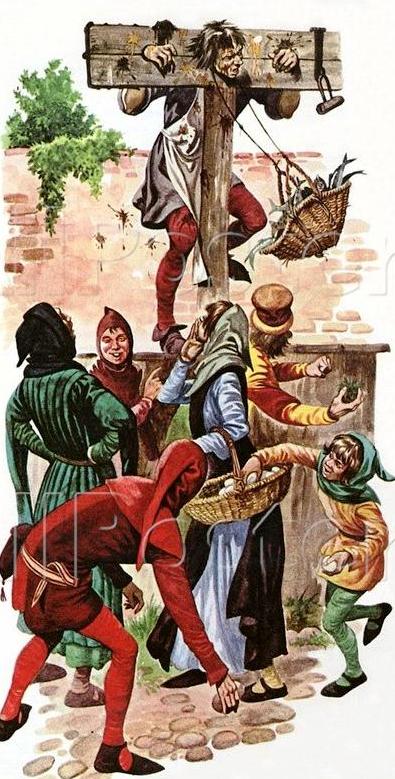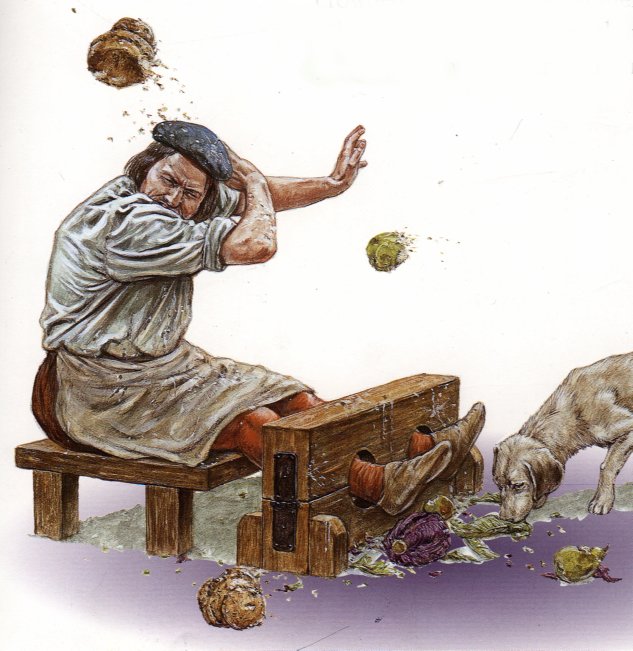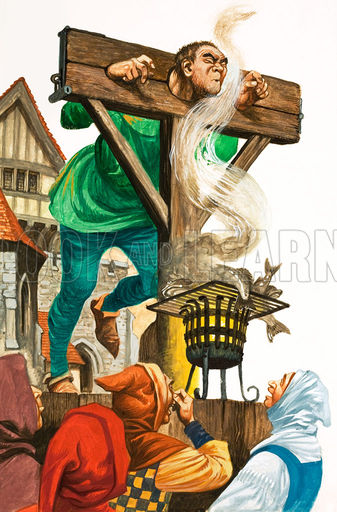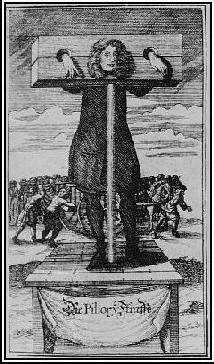 As a general rule, small villages would have a set of stocks,
whereas pillories were more common in towns and cities. In
England, an Act of Parliament was passed in 1405 requiring
every town and village to maintain a set of stocks. Larger towns
forfeited the right to hold markets unless they were equipped
with pillories. A large city like London would have a number of
pillories in different locations.
As a general rule, small villages would have a set of stocks,
whereas pillories were more common in towns and cities. In
England, an Act of Parliament was passed in 1405 requiring
every town and village to maintain a set of stocks. Larger towns
forfeited the right to hold markets unless they were equipped
with pillories. A large city like London would have a number of
pillories in different locations.
Possession of a set of stocks conferred status on small
communities. Any place that was too small or poor to afford
stocks was regarded as a hamlet, and was not entitled to call
itself a village. Mr S M Morris wrote in “The Obsolete
Punishments of Shropshire” that “no village was considered to
be complete, or even worthy of the name of village, without its
stocks, so essential to due order and government were they
deemed to be.”
Stocks and pillories were used to punish a wide range of minor
offences. Drunkenness, prostitution, not attending church; the
list is endless. Under more puritanical regimes, even dancing
round a maypole.
 Some of the more regular occupants of stocks and pillories
were shopkeepers and market stallholders who cheated their
customers. For example, giving short change or measure, or
selling poor quality merchandise. Here the punishment was
often made to fit the crime. A fishmonger who sold rotten fish
would be pilloried with the offending product tied around his
neck. An alewife who watered down her beer would have it
poured over her head while she sat in the stocks.
Some of the more regular occupants of stocks and pillories
were shopkeepers and market stallholders who cheated their
customers. For example, giving short change or measure, or
selling poor quality merchandise. Here the punishment was
often made to fit the crime. A fishmonger who sold rotten fish
would be pilloried with the offending product tied around his
neck. An alewife who watered down her beer would have it
poured over her head while she sat in the stocks.
Here are just a few examples of offences punished by the
stocks or pillory:
In 1500, a young priest sat in the stocks for getting drunk at a village feast.
He was later to become Cardinal Wolsey, Lord Chancellor to King Henry VIII.
 In 1555, a woman was put in the pillory for beating her child.
In 1555, a woman was put in the pillory for beating her child.
In 1556, a procuress was pilloried “for the conveying of harlots
to citizens, apprentices and servants”. Later in the same year, a
child and her mother were pilloried, the one for being a
prostitute and the other “for procuring her own child and
bringing her to whoredom”.
On 3 July 1575, Dorothy Clayton was convicted by the Alderman's Court
in London: she "contrary to all honesty and womanhood commonly goes about the City
apparelled in man's attire. She has abused her body with sundry persons and lived
an incontinent life. On Friday she is to stand in the pillory for two hours in men's
apparell and then to be sent to Bridewell until further order".
In 1637, John Lilburn, for printing and publishing seditious
literature, was sentenced to be whipped through the streets of
Westminster and confined to the pillory.
In 1704, even the famous author, Daniel Defoe (pictured on the right),
was pilloried for writing “The Shortest Way with the Dissenters”.

In Sheffield, on 12 February 1790, for drinking in a
public-house during the time of service in the church, nine men
were locked in the stocks.
In 1810, a man and a woman were pilloried together in Driffield
for fortune telling.
In 1812, a blasphemer was sentenced to the pillory for two
hours. This was repeated each month, for eighteen months.
In Stockport, on 9 August 1822, two women were set in the stocks for
three
hours, one for being drunk, the other for “gross and deliberate
scandal”.
 Some of the more regular occupants of stocks and pillories
were shopkeepers and market stallholders who cheated their
customers. For example, giving short change or measure, or
selling poor quality merchandise. Here the punishment was
often made to fit the crime. A fishmonger who sold rotten fish
would be pilloried with the offending product tied around his
neck. An alewife who watered down her beer would have it
poured over her head while she sat in the stocks.
Some of the more regular occupants of stocks and pillories
were shopkeepers and market stallholders who cheated their
customers. For example, giving short change or measure, or
selling poor quality merchandise. Here the punishment was
often made to fit the crime. A fishmonger who sold rotten fish
would be pilloried with the offending product tied around his
neck. An alewife who watered down her beer would have it
poured over her head while she sat in the stocks. As a general rule, small villages would have a set of stocks,
whereas pillories were more common in towns and cities. In
England, an Act of Parliament was passed in 1405 requiring
every town and village to maintain a set of stocks. Larger towns
forfeited the right to hold markets unless they were equipped
with pillories. A large city like London would have a number of
pillories in different locations.
As a general rule, small villages would have a set of stocks,
whereas pillories were more common in towns and cities. In
England, an Act of Parliament was passed in 1405 requiring
every town and village to maintain a set of stocks. Larger towns
forfeited the right to hold markets unless they were equipped
with pillories. A large city like London would have a number of
pillories in different locations.
 In 1555, a woman was put in the pillory for beating her child.
In 1555, a woman was put in the pillory for beating her child.
